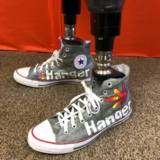Exploring Diabetes and Steps to Improve Health

Amputation due to diabetes is a more common problem than many people realize. But why? Diabetes is a chronic disease affecting over 30 million people in the United States. And according to the World Health Organization, lower-extremity amputations are 10 times more likely in patients with diabetes than in people who do not have diabetes.1 This means if you are living with diabetes, you may be at an increased risk for limb loss.
Exploring Diabetes
Diabetes is a chronic disease that affects how your body turns food into energy. Your body breaks down most of the food you eat into sugar (glucose) and releases it into your bloodstream. When your blood sugar goes up, it signals your pancreas to release insulin. Insulin acts like a key to let the blood sugar into your body’s cells for use as energy.
With diabetes, your body does not make enough insulin or cannot use it as well as it should. When there is not enough insulin or cells stop responding to insulin, too much blood sugar stays in your bloodstream. Over time, poorly controlled diabetes can lead to possible complications including nerve damage from diabetic neuropathy and circulation issues from peripheral artery disease.2
Signs and Symptoms
If you notice any of the following signs and symptoms, make an appointment to see your doctor.
• Increased thirst and urination
• Fatigue
• Blurred vision
• Unexpected weight loss
• Increased hunger
• Slow-healing sores and frequent infections
• Red, swollen gums
• Tingling or numbness in your hands or feet
Understanding possible diabetes symptoms can lead to early diagnosis and treatment, which can help you prevent the complications of diabetes and lead to a lifetime of better health.
Diabetic Neuropathy
Diabetic neuropathy causes nerve damage throughout your body and can cause you to lose feeling or experience numbness, sharp or increased sensitivity, or tingling in your legs and feet. Researchers believe this nerve damage is caused by high blood sugar levels, and the loss of feeling can prevent you from realizing you have injured your legs or feet.2
Peripheral Artery Disease
According to the American Diabetes Association, about 1 in 3 people with diabetes over the age of 50 have peripheral artery disease, caused by a sticky plaque made of cholesterol and fats that builds up on artery walls in the blood vessels in your upper and lower limbs, such as your feet, legs, hands, and arms.3 This reduced blood flow increases the chance of ulcers and infection, and possible need for limb amputation.
Steps to Improving Health
1. Keep Blood Sugar Levels in Target Range
Keeping your blood glucose (blood sugar) levels on target is your best line of defense against neuropathy and peripheral artery disease. Monitor your blood sugar levels using a blood glucose meter and occasional A1C test.3
2. Healthy Diet
Eat healthy foods in moderate amounts at the right times so your blood sugar stays in your target range as much as possible. A diabetes diet is a healthy-eating plan that’s naturally rich in nutrients and low in fat and calories. Key elements are fruits, vegetables, and whole grains.4
3. Physical Activity
Physical activity can improve blood circulation, which strengthens nerve tissues by increasing the flow of oxygen. Exercise can also improve your mental health and overall mood. Exercise programs may include low to moderate impact aerobics and weight bearing exercises. Be sure to check your blood sugar level and drink plenty of water before physical activity. Before beginning new exercises, discuss them with your physician.5
4. Medications
If your physician has prescribed medications, take them as directed.
5. Foot Care
Take care of your feet by checking them daily. Look for any abnormalities including sores, cuts, bumps, and blisters. If you are experiencing any visual issues or are not able to see your feet, use a mirror to assist you or have someone else check your feet. Wear shoes and socks that fit well at all times. Custom inserts, special shoes, and in some cases ankle foot orthoses (AFOs) can be prescribed to take pressure off specific areas of your foot where you struggle to heal and help prevent painful pressure points, blisters, foot ulcers, and sores from developing. If you notice any problems or concerns, seek medical attention immediately.
Diabetes Support
Interested in discovering more about managing diabetic foot complications with the right knowledge, systems, and support?

Diabetes and Amputation
Unmanaged diabetes can lead to amputation, typically of the toes, feet, or legs. But how does this happen? Let’s take a look.
Tara has been living with diabetes but has not made substantial strides to change her lifestyle. She is unable to feel pain in her foot due to numbness from diabetic neuropathy. She has already had two toes amputated from a past infection. Then, she experiences another wound on her foot, but does not notice it because she cannot feel it. She continues on with her life, putting pressure on the affected area, which causes the wound to get larger and become infected.
Once she realizes the wound is there, she tries to take action to heal it. Due to her peripheral artery disease, blood flow is reduced, slowing wound healing and making her body less effective at fighting the infection. As a result, her wound is not healing. Tissue damage and gangrene occur, and the infection then spreads to her bone.
Despite treatment attempts and Tara’s efforts, the damage could not be reversed and the infection could not be stopped, resulting in lower limb amputation.
Prosthetic Care
For those who experience limb loss, a Hanger Clinic prosthetist is here to support you and help you regain your mobility and quality of life. The prosthetist will meet with you to discuss your level of limb loss and lifestyle, often considering a custom designed prosthetic leg and components that are lightweight, durable, and easy to use for someone living with diabetes. In addition, you will talk through post-surgery expectations, rehabilitation, using prosthetic technology, and how to approach the next chapter in life. Managing diabetes can be quite complex but with teams and systems in place to support your needs, you can learn what to do and have access to care when you need it.
Request a Free Evaluation
If you or someone you love is looking for personalized diabetes foot care, contact our Customer Care Center to find a Hanger Clinic footwear location near you.
References
[1] Ole H, Nandita M, Jonathan W, Margolis D; Diabetes, Lower-Extremity Amputation, and Death. Diabetes Care 1 October 2015; 38 (10): 1852–1857.
[2] Centers for Disease Control and Prevention, Diabetes.
[3] American Diabetes Association.
[4] Mayo Clinic, Diseases and Conditions, Diabetes.
[5] Kluding PM, Bareiss SK, Hastings M, Marcus RL, Sinacore DR, Mueller MJ. Physical Training and Activity in People With Diabetic Peripheral Neuropathy: Paradigm Shift. Phys Ther. 2017;97(1):31-43. doi:10.2522/ptj.20160124
Latest Updates
Subscribe to stay up-to-date on our latest posts.



